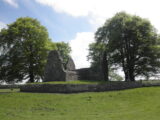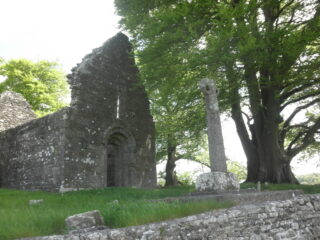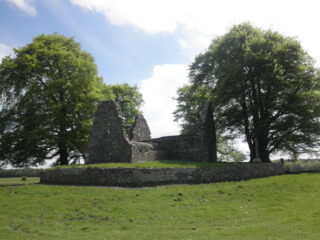Fógra
WARNING: It should be noted that these sites are unguided and a level of care and caution should be maintained during all stages of your visit. The Office Of Public Works (OPW) will not be held responsible for any damages, injuries, or losses that occur
Monaincha Church
Lying within a few kilometres of Roscrea, County Tipperary, Monaincha Church was established sometime during the 12th century on the site of an earlier Christian foundation. Re-erected in the 1940s, a high-cross depicting Christ in the long-robe style of the pilgrims of Lucca faces west. A decorative Hiberno-Romanesque doorway with a sandstone arch, leads into the nave of the church, where the similarly decorated chancel can be seen. A sacristy was later added in the 1400s. Today the inside also houses the gravestones of the Birch family of nearby Birchgrove House, prominent distillers and brewers in Roscrea from the 1700s, who acquired exclusive burial rights at Monaincha Church as it was located on their vast estates.
A sight of pilgrimage and spiritual retreat, Monaincha is associated with Irish saints Canice of Aghaboe, who built the original abbey in the 6th century, Elair who patronised the reforming Culdees (Céilí Dé), and Cronan of Roscrea. The present church was erected by Augustinians who took over services in the 1140s, when the prior of the island was usually represented by a member of the Ó Meachair clan. It fell to ruin when the Augustinians abandoned it in 1485 for nearby Sean Ross. This occurred before the Dissolutions under Henry VIII in the 1500s, so Monaincha was spared from desecration during the Reformation period, continuing as a popular pilgrimage destination and hermitage for monks and friars. A notable pilgrim in 1610 was Bishop Conor O’Devany two years before his execution in Dublin.
While the Irish name for the townland in which the church is situated is Móin na hInse (Bog of the Island), it was originally built on an island in a lake known as Loch Cré and is always referred to in the Irish Annals as Inis Loch Cré, while Inis na mBeo (Island of the Living) is another Irish name applied to it. While today this lake has long been dried up due to drainage from at least the early 19th century, legends of Loch Cré can be found in numerous medieval texts:
According to the Norman-Welsh historian, Giraldus Cambrensis, in his 1188 tract, Topographia Hibernica, there were two islands in Loch Cré:
There is a lake in the northern parts of Munster, containing two islands, one large, the other small. In the larger island there is a church held in great veneration from the earliest times; the smaller island contains a chapel, which is devoutly served by a few celibates, called Heaven-worshippers, or Godworshippers. No woman, nor any animal of the female sex, could ever enter the larger island without instant death... In the smaller island no one ever dies, was ever known to die, or could die a natural death. It is consequently called the Isle of the Living… the natives cause themselves to be ferried over in a boat to the larger island, where they breathe their last as soon as they touch the land.[1]
Loch Cré is also described in an Old Norse text known as the Konungs Skuggsjá (the King’s Mirror), in a section called ‘The Natural Wonders of Ireland’:
In that lake is an islet inhabited by men who live a celibate life and may be called, as one likes, either monks or hermits; they live there in such numbers that they fill the island, though at times they are fewer. It is said concerning this isle that it is healthful and quite free from diseases, so that people grow aged more slowly there than elsewhere in the land. But when one does grow very old and sickly and can see the end of the days allotted by the Lord, he has to be carried to some place on the mainland to die; for no one can die of disease on the island. One may sicken and suffer there, but his spirit cannot depart from the body before he has been removed from the island.[2]
A German named Ludolf von Munchhausen, who had read Topographia Hibernica, made a visit to Loch Cré during his trip to Ireland in the early 1590s. Munchhausen claims that Giraldus was wrong in there being two islands as he saw only one, yet a late 18th century map clearly shows two isles on the lake. While this shows it had not been completely drained by this time, the second island and its chapel have since vanished.[3]
With regards to the isle where no member of the female sex could enter, Munchhausen also tells us that locals indicated several standing stones to him which apparently were originally women who had been turned to stone by God as a result of attempting to enter the island. Titled “Destruction of Monaincha” some local folklore relating to the Cromwellian period was written down by Georgie Griffin for the Schools Collection in the 1930s, and the local tradition of women being turned to stone clearly continued well into the 20th century:
When Cromwell was passing from Clonmel to Dublin he came through Roscrea. When he was on his way to Monahincha he went into a house, and asked the way. The woman of the house was baking a cake and she stopped and went to show him the way. She was immediately turned into a stone and the cake on top of her head, and is to be seen there still.[4]
This “cake” the woman was baking refers to an interestingly carved stonework found at the base of the windows in the nave area of the church.
Visit Historic Environment Viewer for more information on Monaincha Church
Protect our Past - Click here to read about the importance of protecting our country’s unique heritage sites
This national monument is protected in accordance with the National Monuments Acts 1930 to 2014
[1] Thomas Forester (translator), Giraldus Cambrensis: The Topography of Ireland (Ontario, 2000), p. 34, available: https://www.yorku.ca/inpar/topography_ireland.pdf
[2] Laurence Marcellis Larson (translator), The King’s Mirror (London, 1917) p. 109, available: https://archive.org/stream/kingsmirrorspecu00konuuoft/kingsmirrorspecu00konuuoft_djvu.txt
[3] Edward Ledwhich, Antiquities of Ireland (Dublin, 1790) [the map of Monaincha is between pages 68 and 69], available: https://archive.org/details/bim_eighteenth-century_antiquities-of-ireland-_ledwich-edward_1790/page/n87/mode/2up?view=theater
[4] Georgie Griffin, Destruction of Monaincha, National Folklore Collection of UCD, available: https://www.duchas.ie/en/cbes/4922191/4859574/5018100?HighlightText=monaincha&Route=stories&SearchLanguage=ga
Gailearaí
Suíomhanna cóngarach
Caisleán agus Gairdíní Ros Cré, agus Teach Damer/ Muilte Dubha
Áit a léiríonn cumhacht mheánaoiseach agus galántacht ón ochtú haois déag
Timpeall 3.5 km ón
Gairdíní Heywood
Tírdhreach suaimhneach agus rómánsúil ar thaobh cnoic
Timpeall 31.1 km ón
Caisleán agus Gairdíní Phort Omna
Breáthacht ón seachtú haois déag ar bhruacha Loch Deirgeirt
Timpeall 35.3 km ón



